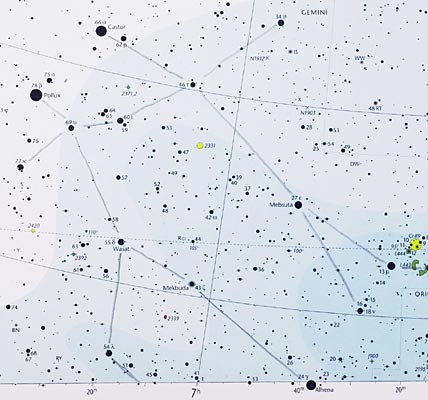
Amid swarms of details on Sky Atlas 2000.0, the naked-eye stars of Gemini are connected here to form their familiar stick figures. Click for larger view.
Copyright 2012 Sky Publishing
By the time you set out into the night with a telescope, you should know the constellations well enough to find your way around the sky. An all-sky constellation star chart (such as the evening chart in the center of Sky & Telescope every month) will get you started. Think of your all-sky star chart as like a map of the world, and the constellations as countries. If you don't know where Japan or England are, you need to learn.
But once you've found England on a world map, it's not much good for getting you to a particular street address in Tunbridge Wells. In addition to a wide-scale constellation star chart, a telescope user needs a more detailed, magnified sky atlas in order to locate specific points of interest.
Using A Star Chart at the Telescope
A standard atlas for serious telescope users is Sky Atlas 2000.0 by Wil Tirion and Roger W. Sinnott. It covers the celestial sphere in 26 big charts that plot a total of 81,000 stars (to as faint as magnitude 8.5) and 2,700 other objects. The smaller Pocket Atlas, with stars to magnitude 7.6, is an excellent low-cost starter and all you'll ever need for binoculars or a telescope of 3-inch aperture or less.
Detailed, zoomed-in star charts may look terribly complex at first. But step back for a minute, squint your eyes, and look at only the brighter stars. These form the same, familiar constellation patterns as on a naked-eye map.
Directions and Distances
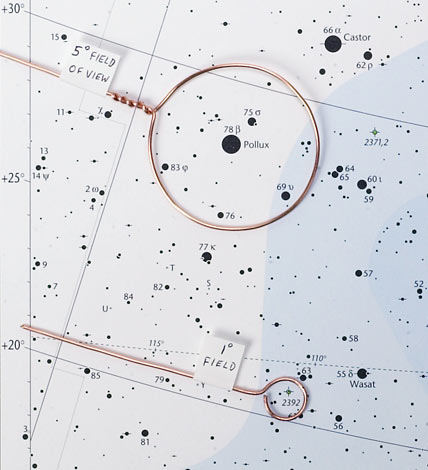
How much of a star chart appears in your eyepiece? You’ll be lost until you know. Handy aids like these tell at a glance. The large wire ring shows the 5° field of a typical finderscope. The small ring shows the 1° field of an average 50x eyepiece’s view. Note the tiny size of the telescopic field, even on a large-scale chart like Sky Atlas 2000.0. Examining the sky at 50 power is almost like examining the chart with a microscope!
Copyright 2017 Sky Publishing
Suppose, for instance, you've learned Gemini as it's drawn on the monthly Sky & Telescope charts, where the stars are connected to form two stick figures holding hands. The same stars of Gemini appear on Chart 5 of Sky Atlas 2000.0 — but at a much larger scale and almost lost in a wealth of detail, as shown above. To keep the familiar naked-eye patterns in perspective, some people draw in the constellation stick figures with a pencil, as we've done here.
Directions on a star chart take a little getting used to. North (up) on a star chart is always the direction toward Polaris in the sky, no matter what part of the sky you're looking at. This is usually tilted at an angle.
East on a star chart is left of north, not to the right like on a map of the ground. The reason is simple: You look down at the ground but up at the sky. (If you looked up through the bottom of a land map of, say, the United States — as if you were at the center of a transparent Earth — it too would have east left when north was up.)
One trick for keeping east and west straight on a celestial map is remembering that right ascension increases to the east (it rhymes). If hours of right ascension are printed along the map's top or bottom, that'll set you straight.
The next step is to learn the star chart's scale. You have to know how much of the scene on paper appears in your finderscope's eyepiece before you can compare the star chart to what you see! As a rough guideline, a typical finderscope shows a field 5° wide, typical binoculars 6° or 7°, and a typical 50x telescope eyepiece shows a field only 1° wide. To see how big these sizes are on your star atlas, compare with the degree scale (the declination scale) along the star chart’s left and right edges.
Knowing the size of your finderscope’s field, and your lowest-power eyepiece's field, is so important that you should make an effort to get it right. To determine the size of your finderscope’s field, locate two stars at night that just fit into its edges (try pairs in the Big Dipper or Cassiopeia). Then see how many degrees apart these stars are on the map, by referring to the scale of degrees along the sides.
Now do the same to find the field diameter of the telescope’s lowest-power eyepiece. It may be hard to find a good star pair on your map to measure a field so small. So here’s another way. Aim at any star in the general area of the celestial equator — in Orion’s Belt, for example, or the Circlet of Pisces, or Procyon, Spica, or Altair. Center the star. Then turn off the telescope’s clock drive (if any), and time how long the star takes to drift from the center of the field to the edge. The time in seconds, divided by 120, equals the field diameter in degrees.
Next, using the scale on the margin of the charts, make little rings out of wire as shown above — or draw circles on clear plastic — corresponding to your field sizes. By sliding these circles across the charts, you can see exactly what star patterns will pass through your field of view when you sweep across the sky.
Beginners are always surprised at how tiny the view turns out to be. Keep these little tools with your charts; you'll want them whenever you observe.
Now we're ready to go on our first deep-sky hunt.
A Practice Star-Hop
A good observing session begins with some indoor planning. Let's use Gemini for a dry run. If you know the constellations, you can find its two bright stars, Pollux and Castor, in the sky. These will be our starting point for practicing using a star chart at the telescope.
A few inches south of Pollux on Chart 5 of Sky Atlas 2000.0 is the planetary nebula NGC 2392, the Clown-Face Nebula, as shown in the scene above (in the 1° wire ring). It is indicated by a little green circle with four spikes. This looks like it might be a nice item to check out! We look it up in Burnham's Celestial Handbook and learn that it is a small, round 8th-magnitude glow. That's bright enough to show in most telescopes. So far so good.
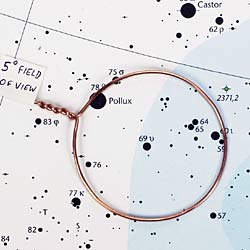
From Pollux, shift your finderscope's field southwest to center on 69 (Upsilon) Geminorum...
The next step is to plan how to get there by star-hopping. Star-hopping just means following a trail of star patterns to move the telescope from a place you know, such as Pollux, to some place you don't, such as the location of the nebula. The trick is not to get lost on the way.
Take the wire ring that corresponds to your finder's field and center it on Pollux, as shown above. Several fainter stars are in the circle, just as they would be if you were looking through the finderscope at the sky. The bright star closest to Pollux is 75 or Sigma (σ) Geminorum, to Pollux's north (in the direction of Castor, which is out of the field of view). Near the southwest edge of the field is the star 69 or Upsilon (υ) Geminorum. It forms a long right triangle with Pollux and 75; Pollux is at the right angle. This triangle confirms 69's identity in the sky — where there's no convenient label next to it!
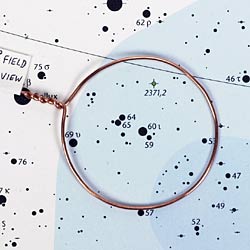
...Shift west to center on 60...
Now shift the wire ring to center on 69, as shown at upper right; this corresponds to moving the telescope. Pollux moves off to the eastern edge of the finderscope's field, and two new pairs of stars enter the opposite edge a little north of due west: 64 and 65 Geminorum, and 59 and 60 Geminorum. These four stars form a distinctive elongated shape.
Shift the ring to center on 60 Geminorum, as shown at right. The fainter star (59) just to its southwest will confirm that you've got the right one.
Star 57 is now just on the south edge of the finder's field. Shift south to center on 57; bright Delta (δ) Geminorum (Wasat) is now waiting just outside to the south. Shift south again an equal amount; Delta quickly appears and can be centered just after 57 leaves to the north.
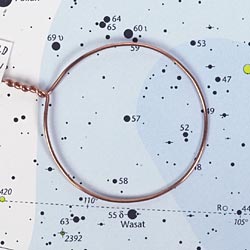
...then south by a little more than half a field to 57...
See how Delta forms an equilateral triangle with 56 and 63, to its south and east? (Bottom panel here.) With 63 now identified (aided by two fainter stars on either side of it) we're less than 1° from our prey.
Note the flat triangle that 63 and 61 form with the little green nebula symbol. The shape of the triangle allows you to target the correct position even if the nebula is invisible, as it may be in the finderscope.
If you do this outdoors at night and move the telescope to match each step on the star chart, NGC 2392 should now be visible in the main eyepiece: a small, dim, eerie round glow quite unlike the pointlike stars, grayish-green in color and with a very faint star at its exact center — a prize worthy of the rather complicated chase.
(Of course, you need to have your finderscope accurately aligned with the main telescope. Do this using a bright star, or a distant treetop in the daytime.)
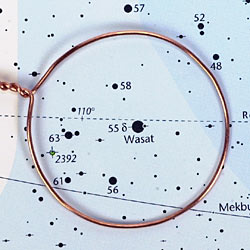
...and south again a little more than half a field to brighter Delta (δ), also known as Wasat.
The star-hopping route may seem like a lot of trouble to the beginner, whose impulse is just to sweep from Pollux "about the right distance that way." But most deep-sky objects are many times dimmer than the faintest stars on whatever chart you're using and won't catch your attention even if, by luck, your tiny telescopic field happens to sweep right across them. The only way to succeed is to know exactly where you are at all times. If you suspect you're lost, go back and start over. Have patience. You'll speed up later as practice increases your skill.
From Map to Sky: Know Your Directions
The biggest pitfall in going from map to sky is keeping your directions straight in the eyepiece.
Remember that in the sky, celestial north is not up but toward Polaris, no matter how cockeyed this direction may be in the eyepiece. It's simple to find the north side of your eyepiece view: just nudge the telescope a bit toward Polaris. New stars will enter the view from the north edge. Turn the map around accordingly, so north on the map is oriented the same way.
This north-nudging trick will soon become such a habit at the telescope that you'll almost forget you're doing it.
If you have an equatorial mount aligned on Polaris, turn the eyepiece of the finderscope so the crosshairs line up with the telescope's motion as you sweep north-south or east-west. The crosshairs will now always mark the four cardinal directions in the view, no matter where you point the scope.
Okay — you've found north in the eyepiece. East and west can be a bit trickier, depending on your telescope.
East is 90° counterclockwise from north if you're looking at a "correct," or right-reading, image — just like on a map. A correct image is given by any optical system that has an even number of mirrors. Examples are a Newtonian reflector, which has two mirrors, or a straight-through refractor, which has zero.
But east is 90° clockwise from north in a mirror image, which is what you see in any optical system that reflects light an odd number of times. The usual culprit is a star diagonal (right-angle attachment at the eyepiece) on a refractor or Cassegrain-style telescope.
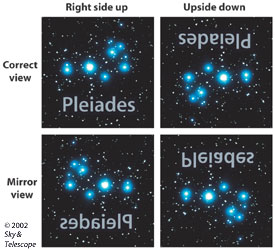
The view in your telescope may be either right-side up (left column) or upside down (right column); this is no big deal. And it is also either correct (top row) or mirror-imaged (bottom row), which is more of a problem. Here are the four possible combinations of the two separate effects.
Sky & Telescope diagram.
Note that this is different from the image merely being upside down. In that case you could just turn the map around upside down too. But a mirror image cannot be made correct no matter how you turn it.
To get a correct image you can simply take out the diagonal and reinsert the eyepiece to view straight through. This is especially important to do to your finderscope, if it came with a diagonal. But straight-through viewing with a refractor or Cassegrain is rarely practical unless your target is near the horizon.
Some observers turn their charts over and shine a flashlight up through the paper from beneath, to view a mirror image of the printing through the blank back side. Better yet, scan the map, flip the scan left-for-right in software, and print out this mirrored version to use at the telescope.
Some people skip this and simply get good at the mental gymnastics of flipping a mirror image left-for-right in their heads. That's more than I can do. A few have even set up a small mirror on their chart table in which to view their maps. Perhaps the best solution is to buy a star diagonal that is made with an Amici prism, which employs two reflections instead of an ordinary diagonal’s one. An Amici-prism diagonal will provide a view of the sky that can be directly compared to your charts.
When star-hopping, always think in terms of north, south, east, and west — never up, down, left, or right, or you'll quickly get lost in trackless wastes of space. Once you get the hang of it you'll always be mumbling as you turn from map to scope: "Starting from that bright one in the north of the kite shape . . . half a finder field east to the pair in the skinny triangle . . . a quarter finder field south to the one at the west end of the flat triangle . . . " Triangles are the most basic units of star-hop patterns, and you'll be seeing a lot of them. Single stars look alike, but every triangle is different. Quadrilaterals even more so.
Like anything else, you get good at it by doing it. Go have fun!
 3
3








Comments
Luiz Lima
January 29, 2018 at 1:30 pm
Alan MacRobert,
Although I don't have any training in the area, I was always interested in astronomy.
This your "How to use the Star Chart at the Telescope" class was great.
I will follow your site from now on and I'll recommend it to my friends.
Luiz Lima
You must be logged in to post a comment.
StarRunner188
September 4, 2019 at 11:53 am
Hello Alan, this is really valuable, thank you. These “tutorials to bring you from beginner to intermediate level” are a strong contribution from Sky and Telescope!
You must be logged in to post a comment.
You must be logged in to post a comment.